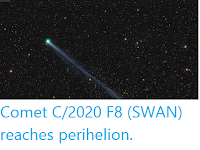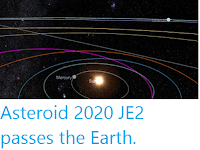Asteroid 2020 KK7 passed by the Earth at a distance of about 512 700
km (1.34 times the average distance between the Earth and the Moon, or
0.34% of the distance between the Earth and the Sun), slightlybefore 9.45 am
GMT on Tuesday 2 June 2020. There was no danger of
the asteroid hitting us, though were it to do so it would not have
presented a significant threat. 2020 KK7 has an estimated
equivalent
diameter of 10-32 m (i.e. it is estimated that a spherical object
with
the same volume would be 10-32 m in diameter), and an object of this
size
would be expected to explode in
an airburst (an explosion caused by superheating from friction with the
Earth's atmosphere, which is greater than that caused by simply
falling, due to the orbital momentum of the asteroid) in the atmosphere between 32 and 15 km above the ground, with only fragmentary material
reaching the Earth's surface.
Asteroid 2020 KK7 imaged on 1 June 2020 from London, England. Image
is a composite made up of 150 two second exposures. Asteroid is the point indicated by the red lines, which has moved only slightly
over the course of the image gathering, while the longer lines are stars that have moved considerably in the same time. Northolt Branch Observatories/Facebook.
2020 KK7 was discovered on 25 May 2020 (eight days before its closest encounter with the Earth) by the
University of Arizona's Mt. Lemmon Survey at the Steward Observatory on Mount
Lemmon in the Catalina Mountains north of Tucson. The designation 2020 KK7 implies that the asteroid was the 178th object (asteroid N1 -
in numbering asteroids the letters A-Y, excluding I, are assigned
numbers from 1 to 24, with a number added to the end each time the
alphabet is ended, so that A = 1, A1 = 25, A2 = 49, etc, so that K7 = (24 x 7) + 10 = 178) discovered in the second half of May 2020 (period 2020 K - the
year being split into 24 half-months represented by the letters A-Y, with I being excluded).
2020 KK7 has an 1257 day (3.44 year) orbital period and an eccentric orbit
tilted at an angle of 2.42° to the plane of the Solar System, which
takes it from 0.82 AU from the Sun (i.e. 82% of the the average distance at
which the Earth orbits the Sun) to 3.74 AU from the Sun (i.e. 374% of
the
average distance at which the Earth orbits the Sun, more than twice the distance at which Mars orbits the Sun). It is therefore
classed as an
Apollo Group Asteroid (an asteroid that is on average further from the
Sun than the Earth, but which does get closer).
The orbit and current position of Asteroid 2020 KK7. The Sky Live 3D Solar System Simulator.
This is thought to by 2020 KK7's first close encounter with the Earth, having been shifted onto it's current orbit by a close encounter with Jupiter in May 2015. It is expected to have close encounters with the planet Venus in July this year (2020), and October 2088, followed by another close encounter with the Earth in October 2163, after which it will be lost from the inner Solar System.
See also...
Follow Sciency Thoughts on Facebook.








